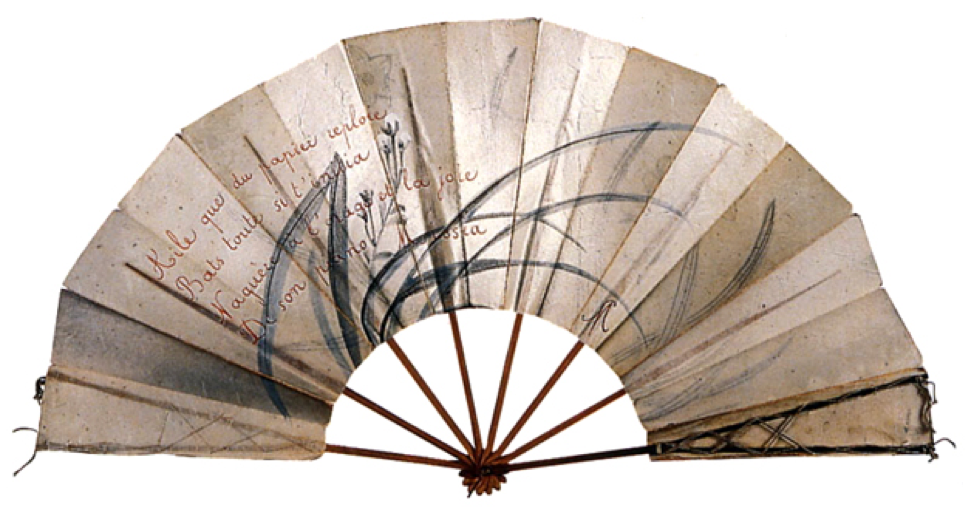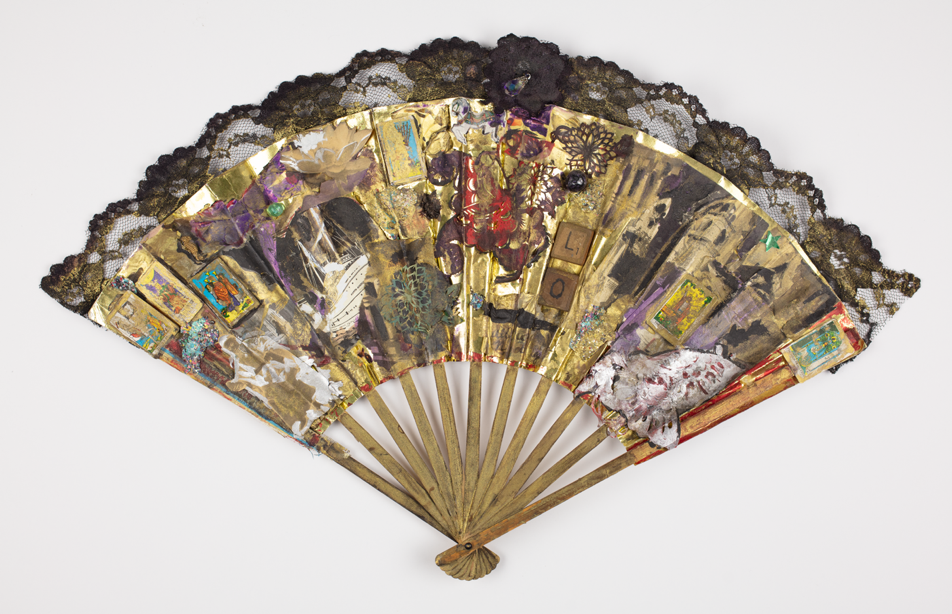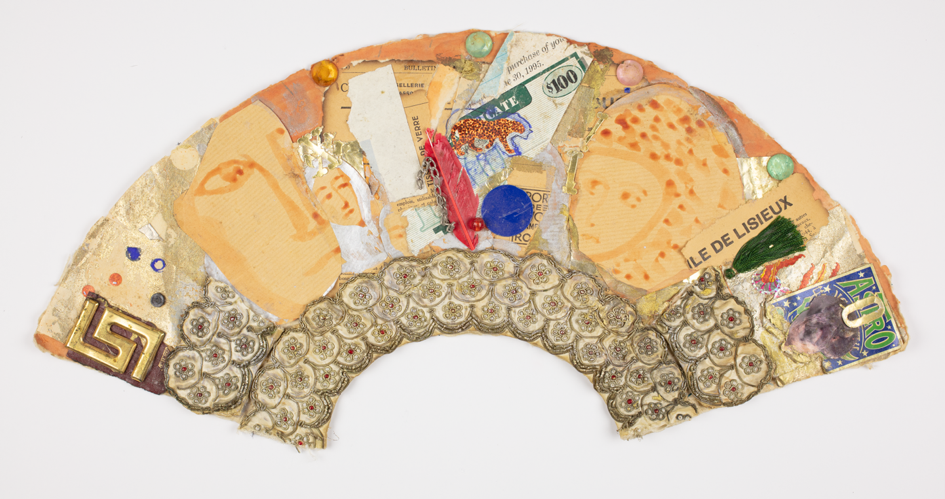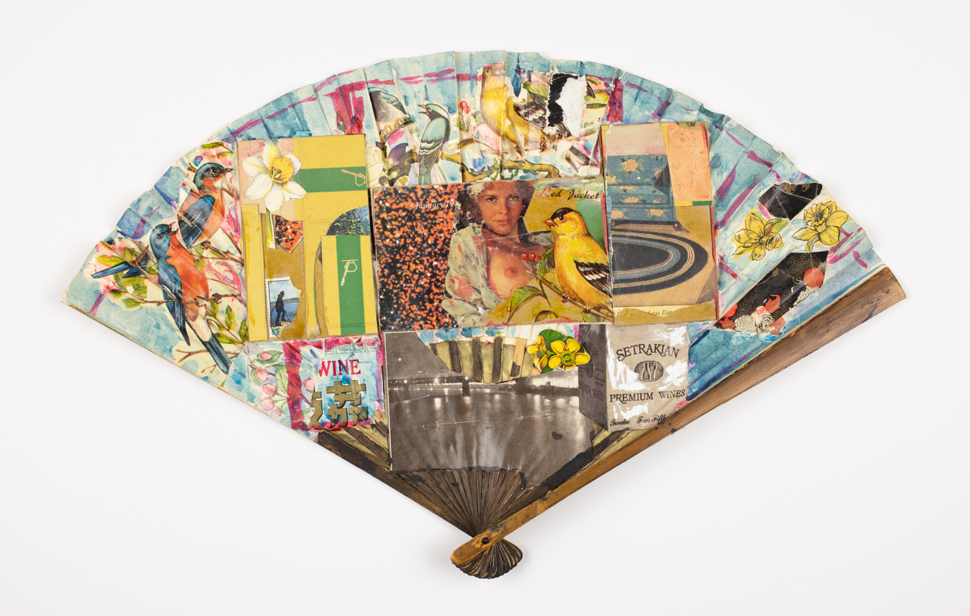‘Spirit Flows From Pieces’: Alice Notley’s Collage Art

Editor's Note: A portfolio of Alice Notley's collage art is featured in the September 2019 issue of Poetry magazine. The full portfolio can be found here.
When my plane touched down in Paris, it coincided with a brutal late-August heat wave. My rented flat was sweltering, even at midnight. I didn’t know the neighborhood, how safe it was for a woman alone to leave her window open while sleeping—so I kept it shut even when the night air might cool it down. I woke up often, sweating in the dark, until I wandered to the shower to soak my hair in cold water, then flopped back into my Murphy bed. The relief this provided was fleeting, but better than nothing.
I tried restricting my walks around the city to the morning—when the building’s shadows were long and still held some of the night’s coolness. But the heat started early, too. With the muggy warmth came the people (usually women) fanning themselves while moving through the baked Parisian streets. You likely know the kind of object they held in their hands: a cheap fabric fan, its plastic sticks giving a gratifying clack when flicked open. These are usually shiny, maybe affixed with lace, and often fall apart quickly. Almost every newspaper stand sold them for some change.
I was in Paris to look more closely at fans—specifically those the poet Alice Notley had made into collage art objects for almost 50 years. I had coordinated with Notley to come to her Paris apartment to look at her fans and talk about them together. During one morning’s interview, Notley brought up her small desert hometown of Needles, California. She said, “Being from Needles, I was worried I was going to turn into a crank. And then I did! I started making things from broken glass and junk…You turn into a crank [in Needles] because it’s so hot you might just become infinity at any moment.” So, despite the heat, or because of it, and seeing so many fans flickering out in the wild, it all felt auspicious. Like something was telling me I was in the right place.
*
Fans are old. We trace them back farthest to China in the 6th century BCE, but they were also in ancient Greece and Japan. They have been made from feathers, cypress, bamboo, silk, mica, bone, pearl, palm leaf, straw. The fan’s use varies from an accessory in dance, a means to heat embers, a weapon, to ward off insects, to bless wine, relay military signals, provide a cooling breeze. The scholar Yulia Ryzhik writes, “Even at its origin the fan was both an ephemeral object, to be thrown away when worn out, and a precious object made for sacred, ceremonial, or royal usage.” The Chinese 扇 or “fan” is, at its etymological roots, the image of a roof hanging over feathers.
The earliest were “fixed” fans—that which was like a frond or a large slice from a circle, perhaps with an ornamental handle. The “folding” fan, what contemporary Parisians were using to keep cool, wasn’t invented for another millennium after the first known fan’s creation. Influenced by the Chinese original, the folding fan with its strips of wood holding open paper or fabric was developed in Japan. The number of ribs in a fan indicated a person’s rank in the Heian Era. The folding fan’s ability to close, to contain something unseen, imbued the function of privacy we now associate with the accessory. Ryzhik also writes,
one of the fan’s many functions was to keep secrets. The bearer could observe others from behind a fan (some fans even had cut outs for eyes), speak in confidence without risking that someone might read her lips…In the eleventh century Japanese novel The Tale of Genji, lovers exchange fans as gifts and convey messages on them. In the 1996 film Ridicule…a lady uses her fan to help her lover cheat at a parlor game.
Notley’s use of fans contain secrets in their own way, too. But rather than obscure information, they bear them up—like all art—for us to try to understand. “I always wanted them to be beautiful,” she told me. “I think that was the main thing I wanted from them—that they be beautiful for me. I did them for myself.” While there are only words here and there on her fans, one fan’s lines read: “Breathtaking black star / Press yourself into my depths.”
*
Notley is hardly the first person to put text on fans—the Chinese started doing that centuries ago. She’s not the first poet to do it, either. Not even the first in France. Stéphane Mallarmé, the poet often most associated with French Symbolism in the 19th century, was also taken with the folding fan as a surface for his verse. Like Notley, he gave fans to his family members and close friends. The most famous of Mallarmé’s poetry fans contains a single quatrain for his wife Missia:
Aile que du papier reploie
Bats toute si t’initia
Naguère à l’orage et la joie
De son piano Missia
*
Wing of folded paper
Beat quick, as if moved
Before from the storm and joy
Of Missia’s piano
(my translation)
Mallarmé’s attention to the folding fan was in part due to the French obsession with Japanese culture in the late-19th century (japonisme). And, beginning in the 16th century in Europe, the fan, according to one scholar, Sergio Villani, “became the object of the finest craftsmen who labored masterfully on its leaf in order to please the refined tastes of gentleladies. The leaf’s central representation, often mythological in nature, was framed by other pictoral or engraved motifs which unfolded a story every time the fan was opened.” Thus Notley—who fixes the fans open before beginning her work—gives us endless view to those stories, lets us read them again and again. She alters the fan’s ancient function of adornment and secrecy to one bearing collage and giving access.
Mallarmé and Notley have one more thing in common, which I discovered in a footnote of a dissertation on the former. Doctoral student Séverine C. Martin visited Le Musée de l’Éventail, or the Fan Museum, in Paris, during which the curator “scoffed” at her “for daring to compare Mallarmé’s fan poems with the extraordinary collection of fans she has on display in the museum, precisely because Mallarmé’s fans were made of very poor materials.” For Notley’s aim for beauty is true despite the fact her fans are covered with paint, stickers, and, above all, what even she calls garbage.
*
Notley’s use of trash in her visual work is one of its most striking features. When I write “trash,” I mean it literally. When she told me about her method of locating items to use in her collages, she told me, “I find things on the street.” While Notley was friends with and informed by other collage artists in New York in the 1970s like Joe Brainard and George Schneeman, their collages were rarely made with trash. She often used the scraps Brainard and Schneeman didn’t want or need. She took whatever she could find. In her poem “Waveland (Back in Chicago),” Notley writes, “I’m thinking with my hands—a ploy against fear— / I have a pile of garbage on the floor /… / I must be making my own universe / out of discards.”
I first learned about Notley’s visual art while reading a themed issue of The Volta. The topic was “trash,” and Claudia Keelan interviewed Notley about her nearly exclusive use of detritus in her collage work. Regarding her process of making fans into art, Notley tells Keelan,
First I acquire a cheap fan. Then I usually have to do something to the back of it to make it stay open, glue cardboard strips on maybe. Then glue one or two things lying around on it. Then set it somewhere where I’ll see it a lot at least subliminally. I commence to find things on the street or in my apartment that go with it.
For decades, Notley has learned and cultivated how to make her own universe from found things.
After reading Notley’s descriptions of her art, I made a vow: go to the special collections at UC-San Diego and see them for myself. The need for those archives came up in my doctoral work—indeed, while researching a chapter on Notley’s writings about her brother and his early death. So, at end of my last day with only a couple of hours to spare, I speedily requested box upon box of her art, scanning all I could before the library closed for the evening. While there were dozens of fans, there was so much more—an old diner sign advertising the special that day of pot cheese with sour cream, a woman in a suggestive pose pasted beside with a cartoon visage covering the model’s turned face. There were masks and picture frames and objects ranging from the size of a cracker to a tabletop. They were covered in beer labels, cheap beads, torn ticket stubs, hair ties, fake coins, and typed ads with Notley’s own script intermixed. And while so many of these were thrilling to look over, it was her fans kept that pulling me in. They made me want to ask her to explain them, show me how to read them, put them together in a book.
Months later, she would tell me, “When you’re making art, you’re always evoking words. All the Medieval art I’ve been looking at lately is all in a context of being made for people who can’t read. So the art is being read. It’s meant to be read.” The shape of the fan, it seems, guides the reading eye more directly than a rectangle canvas might. It is the artist’s decision what to feature on that canvas to draw the viewer’s eye to one point or another, rather than the canvas’s shape doing that work. Yet the open fan has inherent dynamism and direction. The impulse of its shape is to act as a diorama, something that tells a story. As Notley explained to me, “It kind of opens and it goes across in that particular fan shape rather than being a monument wholly in place like a rectangle. It keeps opening, and then you come back to the beginning.” The shape of the fan invites you to read and reread it. The masses of objects in her collage invite you, too—you will find something you had missed while perusing it just a moment before.
*
When Keelan tells her, “Everything you’ve said about making fans shows a recycling,” Notley pushes back, saying, “I’m not interested in recycling. The things I find I consider to be beautiful, partly because they’ve already been used. I’m simply attracted to shape and color and pattern, with a patina of use on them.” That which has “been used”—and then drops from an open palm or slips from a pocket’s rent seam—infuses those objects with something valuable for Notley. They bear an aura of function, spent. Or cut short and distorted (as, say, with a foil cigarette pack run over by a car). But that they were once worried by fingers or sat in an earlobe gives these things far more meaning than new or purchased collage items ever could. “I think my materials have more history attached to them,” Notley tells Keelan. As she explained to me, “I like things that are already torn. I like the sense that these transient objects have a history and that you could read it. And that it makes more and more being. Everything is on top of everything.” The items within her collages bear a kind of collage themselves—that of history, as illustrated through their wear.
The use of trash in Notley’s art, and her collage fans in particular, are the most political elements of her artwork. And I agree with Notley—it is not merely recycling (which is certainly political act enough). The politics, to me, have to do with the fan and the trash Notley places onto it. She told me, “What I was doing by making collage fans was violate the function of the fan. I was going to make it super rigid, so that you could never close it, and I was going to make it too heavy.” She explains to Keelan, “The idea is to make it stiffer and stiffer until it’s all art…Art is rigid, motionless.” The heart of the politics I mention is Notley’s decision to “violate the function” of an object largely tied to femininity (the fan), by similarly “violating the function” of what most would describe as trash—and combining these to make them art. This femme disposable thing is hardened with other disposable ephemera. Notley stiffens and encumbers that which we usually associate with rapid movement, and tells us to look closer and read.
This transformation of what we know is directly connected with Notley’s poetics, particularly The Descent of Alette, in which Notley grappled directly with the epic—one of the most distinctly male-oriented forms in literature’s history—to make what she calls a “feminine” epic. Notley accomplished this in a myriad of ways. There are quotation marks denoting metric feet, slowing down the reader and giving the poem a feeling of incantation, chorus, and testimony. She adhered, almost compulsively, to Joseph Campbell’s elements in “the hero’s journey,” but with important feminist inversions—including having her female protagonist, rather than go upward to reach enlightenment, move deeper into the earth for knowledge.
There is a kinship in this inventiveness of poetic form and collage. To see a thing ascribed a specific function—“lost item,” “trash” “femme cooling tool,” “male hero’s journey”—and make it something else entirely is a kind of alchemy that can only be read as a commentary on its original material. Notley ultimately uses this process as a means of form, no matter her project. She told me, “I liked the feeling, when making collages, that I was doing something that I did when I made poems. That it was really about form in an abstract way.”
The question of “why trash?” beyond politics of aesthetics is a fair one, and Notley’s answer to that has political concerns, too. At one point, Notley tells Keelan, “artists who use found materials tend to be poor. I don’t have any money; I can’t spend on materials.” As a female poet and artist with no consistent employment in a patriarchal world—a world which Notley attempts to dissect in her work time and again—she is given very few resources. The work she does is ascribed little monetary worth, and Notley has never had any interest in holding a “job” (teaching or otherwise). So she takes anything she can get her hands on—gum wrappers, baseball cards—and makes something with them. She explains to Keelan,
My fans are covered with bits of paper imbued with other peoples’ and my use, living, touch. By making [the fans] I enter the force that’s universal purpose, which has us all by the nape of the neck, though we barely realize it unless someone dies. But. When I take the time to make something by hand, I enter that place where we are shaped as I shape something…We are all together our own creative force. We create the world, because we create what we think about it. There’s no way of knowing if it would exist without us. Art is about all of this, as we make it it tells us we are the creator.
The power of creativity in the face of a world build to disempower you time and again is radical work. To take up that which people ascribe little value and use it for this empowerment, even more so.
*
One of my favorite fans of Notley’s incorporates an old postcard of the Parthenon. She’s torn it up so it looks like the ancient structure is exploding, its pillars becoming the fan’s wooden ribs. A red cartoon bird peaks out from one of the blown-up edges. Parts of an octopus are on the fan’s fringes, mostly painted gold. Black star stickers, like so many of us had as children, are scattered around. It is one of the few fans that contains what one might argue is a full poem, a line of which reads: “It isn’t marred but broken / spirit flows from pieces : // : Whatever breaks / owns the universe.” In all of her work—whether it is the poetic line or affixing of a magazine ad on a fan—Notley shows the spirit that emerges from that which is breaks apart. The strength that remains despite, the access breaking gives. It is hard not to project the emotion of breaking onto this notion. The transmutation of this idea of brokenness into strength is a kind of spell. “Art changes the way we see…the combines make us see garbage as beautiful or interesting or funny,” Notley says. “Art is magical.” Notley’s strength, too, is in marshalling these pieces, otherwise foreign to one another, together. To show us the spirit that vibrates with their proximity.
Diana Arterian is the author of the poetry collection Playing Monster :: Seiche (1913 Press, 2017), ...
Read Full Biography





